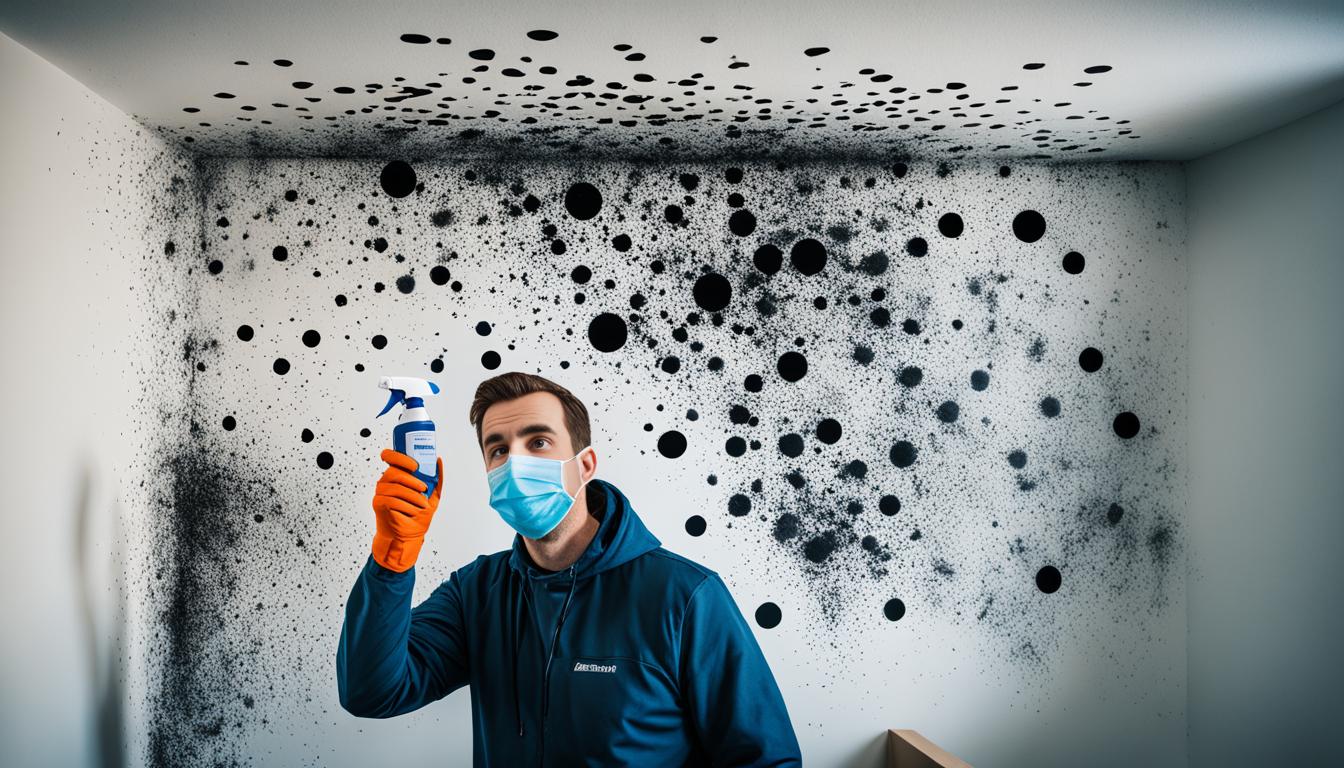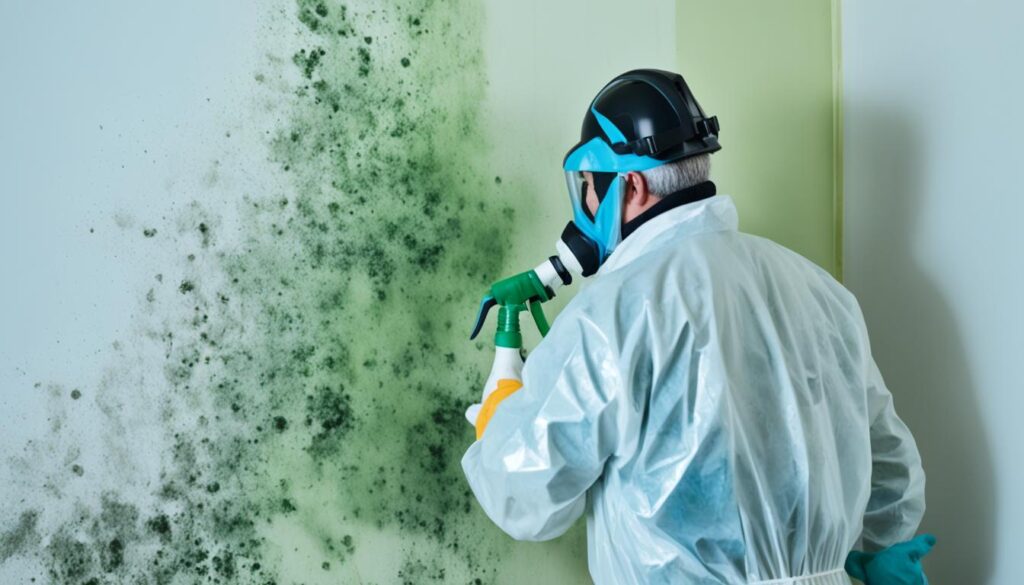
Understanding Mold in Spanish – Remediation Tips
Welcome to our comprehensive guide on understanding mold in Spanish and effective remediation tips. Mold growth can be a major concern for homeowners, posing risks to both property and health. By gaining a deeper understanding of mold and its specific terms in Spanish, you’ll be better equipped to address and prevent mold issues in your home.
Mold, or “moho” in Spanish, refers to a type of fungus that thrives in damp environments. It can appear in various colors, including black, green, or white, and may have a distinctive musty smell. Mold growth is often associated with moisture-related problems such as leaks, poor ventilation, or high humidity levels.
When it comes to dealing with mold, it’s essential to identify its presence accurately. Mold can grow on different surfaces, including walls, ceilings, carpets, and even furniture. Keep an eye out for visible signs such as discoloration or patches, as well as allergic reactions like coughing, sneezing, or skin irritations.
To effectively tackle mold issues in your home, it’s important to take the necessary remediation steps in a safe and efficient manner. This includes wearing protective gear like gloves, masks, and goggles, isolating the affected area, and utilizing appropriate cleaning agents. Following proper guidelines helps in preventing cross-contamination and ensures thorough removal of mold.
In the upcoming sections, we will delve deeper into identifying mold in Spanish and provide practical remediation tips that you can implement to combat mold growth effectively. Stay tuned to learn more!
Key Takeaways:
- Understanding mold in Spanish (“moho”) is crucial for addressing mold issues in Spanish-speaking households.
- Mold is a type of fungus that thrives in damp environments and can appear in various colors.
- Identifying mold includes recognizing visual signs and being aware of potential allergic reactions.
- Proper remediation steps, such as wearing protective gear and utilizing appropriate cleaning agents, are essential for effective mold removal.
- Stay tuned for the next sections where we will discuss mold identification in Spanish and provide practical remediation tips.
Identifying Mold in Spanish
When it comes to mold in your home, timely identification is crucial for effective remediation. In this section, we will explore the various signs and indicators that can help you identify the presence of mold. We’ll also provide you with Spanish terms related to mold, making it easier for Spanish-speaking individuals to communicate their concerns.
Signs of Mold Presence
- Visible growth: Mold usually appears as dark spots or patches on walls, ceilings, or other surfaces.
- Musty odor: An unpleasant and persistent musty smell can often indicate mold growth.
- Water damage: If your home has experienced water leaks, floods, or excessive moisture, it increases the likelihood of mold growth.
- Allergic reactions: Symptoms like sneezing, coughing, watery eyes, and skin rashes, especially when indoors, may be signs of mold exposure.
In addition to these common signs, it’s important to be aware of the Spanish terms for mold to better communicate with professionals and other Spanish-speaking individuals. Here are some useful terms:
“Moho” is the general term for mold in Spanish, while “hongo” specifically refers to fungal growth.
If you notice black mold, it is known as “moho negro” or “moho tóxico” in Spanish.
“Levadura” refers to yeast, which is a type of fungus often associated with mold growth.
By being familiar with these Spanish terms, you can effectively communicate your concerns and better understand any discussions related to mold remediation.

It’s important to note that mold identification is the first step towards addressing the issue. In the next section, we will go into detail about effective mold remediation techniques in Spanish, providing you with the knowledge to tackle mold growth head-on.
Tackling Mold in Spanish – Remediation Tips
In this section, we will explore effective techniques for mold remediation in Spanish. Mold can pose serious health risks, so it’s essential to address the issue promptly and efficiently. Whether you are a Spanish-speaking homeowner, landlord, or property manager, these tips will guide you in protecting your property and maintaining a healthy living environment.
Preventive Measures to Avoid Mold Growth
Prevention is key when it comes to mold. By implementing these measures, you can significantly reduce the chances of mold growth in your home:
- Ensure proper ventilation and airflow in high-humidity areas, such as bathrooms, kitchens, and basements.
- Regularly clean and dry areas prone to moisture, including sinks, showers, and windowsills.
- Fix any leaks or water damage promptly to prevent mold from thriving in damp areas.
- Use mold-resistant materials, such as mold-resistant drywall and paint, in areas prone to moisture.
- Monitor indoor humidity levels and keep them below 50% to discourage mold growth.
Implementing these preventive measures can significantly reduce the likelihood of mold taking hold in your home. However, if you already have a mold problem, it’s crucial to take immediate action to remediate the issue.
Safely Removing Mold from Your Home
When dealing with mold, it’s essential to prioritize your safety and follow proper remediation procedures. Here’s a step-by-step guide to safely remove mold from your home:
- Wear protective gear, including gloves, goggles, and a respirator, to prevent inhalation and direct contact with mold spores.
- Identify the source of moisture and address it by fixing leaks or improving ventilation.
- Contain the affected area by sealing off doors, windows, and vents with plastic sheeting and duct tape.
- Remove any porous materials, such as drywall or carpeting, that are heavily infested with mold and cannot be thoroughly cleaned.
- Clean non-porous surfaces, such as tile, countertops, and glass, with a mixture of detergent and water.
- Disinfect the cleaned surfaces with a solution of bleach and water (one cup of bleach per gallon of water).
- Thoroughly dry the area using fans, dehumidifiers, or natural ventilation.
- Monitor the area for any signs of recurring mold growth and address any underlying moisture issues promptly.
Following these steps will help you effectively remediate mold and prevent its return. However, if you are uncertain or dealing with extensive mold growth, it’s advisable to seek professional mold remediation services to ensure thorough elimination.

By taking proactive measures to prevent mold growth and following proper remediation techniques, you can protect your home from the damaging effects of mold. Regular maintenance and vigilance are key to maintaining a safe and healthy living environment.
Conclusion
In conclusion, understanding mold in Spanish is crucial for effectively addressing mold issues in your home. By identifying mold and utilizing the appropriate remediation techniques, you can safeguard both your property and your health.
If you suspect mold growth in your home, it is essential to take immediate action. Mold not only damages the structure of your property but also poses serious health risks, especially to individuals with respiratory conditions or weakened immune systems.
For professional mold assessment and comprehensive removal, contact Fix Mold Miami at 305-465-6653. Our experienced team will provide expert guidance and ensure that your home is mold-free, allowing you to breathe easy and enjoy a healthy living environment.




